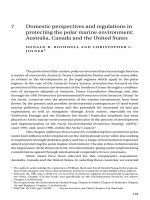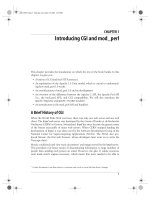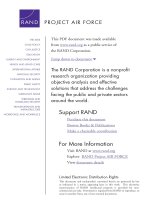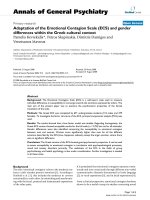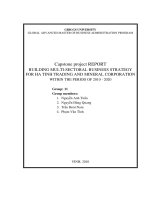Understanding business 10th chapter 1 taking risks and making profits within the dynamic business environment
Bạn đang xem bản rút gọn của tài liệu. Xem và tải ngay bản đầy đủ của tài liệu tại đây (96.68 KB, 52 trang )
Chapter 01
Taking Risks
and Making
Profits within
the Dynamic
Business
Environment
McGraw-Hill/Irwin
Copyright © 2014 by The McGraw-Hill Companies, Inc. All rights reserved.
Profile
MONIF CLARKE
Monif C. Contemporary Plus Sizes
• Plus-sized woman wanted
luxurious and feminine clothing.
• Borrowed $30,000 to start her
own clothing line.
• Took classes at New York’s
Fashion Institute of Technology
to make business contacts.
• Adapted products and prices to
meet the changing needs of her
customers after economic
downturn.
1-2
Chapter One
LEARNING GOALS
1. Describe the relationship between profit and
risk, and show how businesses and nonprofits
can raise the standard of living for all.
2. Compare and contrast being an entrepreneur
and working for others.
3. Analyze the effects of the economic
environment and taxes on businesses.
4. Describe the effects of technology on
businesses.
1-3
Chapter One
LEARNING GOALS
5. Demonstrate how businesses can meet and
beat competition.
6. Analyze the social changes affecting
businesses.
7. Identify what businesses must do to meet
global challenges, including war and terrorism.
8. Review how past trends are being repeated in
the present and what those trends mean for
tomorrow’s college graduates.
1-4
Chapter One
NAME that COMPANY
This microlending organization provides small
loans to entrepreneurs too poor to qualify for
traditional loans. The person who started this
organization has started 30 of what he calls
social businesses that do not have profit as
their goal.
Name that organization and its founder!
1-5
Entrepreneurship
and
Wealth Building
GOODS and SERVICES
LG1
• Goods -- Tangible products such as computers,
food, clothing, cars and appliances.
• Services -- Intangible products (that can’t be held
in your hand) like education, healthcare, insurance,
recreation and travel.
• Successfully filling a market need means you
could make money for yourself and provide
jobs for others.
1-6
Entrepreneurship
and
Wealth Building
LG1
BUSINESS and
ENTREPRENEURSHIP
• Business -- Any activity that seeks to provide
goods and services to others while operating at a
profit.
• Entrepreneur -- A person who risks time and
money to start and manage a business.
• Success in business is often based on the
strategy of finding a need and filling it.
1-7
Revenues,
Profits
and Losses
REVENUE, PROFIT AND LOSS
LG1
• Revenue -- The total amount
of money a business takes in
during a given period by selling
goods and services.
• Profit -- The amount of money
a business earns above and
beyond what it spends for
salaries and other expenses.
• Loss -- Occurs when a
business’s expenses are more
than its revenues.
1-8
Matching Risk
with Profit
RISK
LG1
• Risk -- The chance an
entrepreneur takes of losing time
and money on a business that may
not prove profitable.
• Not all businesses make the
same amount of profit.
• Businesses take risks, but with
great risks could come great
profit.
1-9
Businesses Add
to the Standard of
Living and Quality
of Life
LG1
HOW is TAX MONEY USED?
Taxes are used to provide:
•Hospitals
•Schools
•Libraries
•Playgrounds
•Roads
•Fire Protection
•Police Protection
•Environmental Programs
•Support for People in Need
•_____________________
_
1-10
Businesses Add
to the Standard of
Living and Quality
of Life
LG1
STANDARD of LIVING
• Standard of Living -- The
amount of goods and services
people can buy with the money
they have.
• The U.S. has one of the highest
standards of living in the world.
• Workers in other countries may
make more money, but prices for
products are higher.
Photo courtesy of Walmart Stores
1-11
Businesses Add
to the Standard of
Living and Quality
of Life
LG1
QUALITY of LIFE
• Quality of Life -- The general well-being of a
society in terms of its political freedom, natural
environment, education, healthcare, safety, amount
of leisure and rewards that add to personal
satisfaction.
1-12
Responding to the
Various Business
Stakeholders
STAKEHOLDERS
LG1
• Stakeholders -- All the people who stand to gain
or lose by the policies and activities of a business
and whose concerns the businesses need to
address.
• Who are Stakeholders?
___ Customers
___ Community Members
___
___
___
___
___
___
___
___
___
___
Employees
Stockholders
Suppliers
Owners
Dealers
Media
Elected Officials
Bankers
Environmentalists
________________
1-13
Responding to the
Various Business
Stakeholders
LG1
OUTSOURCING
and INSOURCING
• Outsourcing -- Contracting with other companies
(often in other countries) to do some of the firm’s
functions, like production or accounting.
• Insourcing -- Foreign companies opening offices
and factories in the United States.
1-14
Using Business
Principles in
Nonprofit
Organizations
NONPROFIT ORGANIZATIONS
LG1
• Nonprofit Organization -- An organization whose
goals do not include making a personal profit for its
owners or organizers.
1-15
Using
Business
Principles in
Nonprofit
Organizations
WELL-KNOWN NONPROFITS
in the UNITED STATES
LG1
United Way
Salvation Army
American Heart Associatio
n
American Cancer Society
American Red Cross
1-16
Using
Business
Principles in
Nonprofit
Organizations
LG1
KEEPING STRONG EMPLOYEES
at NONPROFITS
1. Set ambitious, but
realistic goals.
2. Allow all employees to
work with the groups
they are serving.
3. Give employees a break.
Nonprofit work is
draining.
Source: Fast Company, March 2010.
1-17
Using Business
Principles in
Nonprofit
Organizations
SOCIAL ENTREPRENEURS
LG1
• Social entrepreneurs use
business principles to
start and manage not-forprofit organizations to
address social issues.
• Muhammad Yunus won
the Nobel Peace Prize
for starting Grameen
Bank.
1-18
Progress
Assessment
PROGRESS ASSESSMENT
• What’s the difference between revenue and
profit?
• What’s the difference between standard of living
and quality of life?
• What’s risk? How is it related to profit?
• What do the terms stakeholders, outsourcing and
insourcing mean?
1-19
Entrepreneurship
Versus Working for
Others
LG2
THE UPS and DOWNS
of ENTREPRENEURSHIP
The UPS
The DOWNS
The freedom to succeed.
The freedom to fail.
Make your own decisions.
No paid vacations.
High possibility of wealth.
No health insurance.
Hire your own staff.
No daycare.
1-20
Opportunities for
Entrepreneurs
LG2
WHO TAKES the
ENTREPRENEURIAL CHALLENGE?
• Millions of people have
started businesses and
succeeded.
• The number of Hispanicowned businesses in the
U.S. has grown
dramatically.
• Women now own one-third
of all businesses.
1-21
NETWORKING of MINORITY
BUSINESSES
(Spotlight on Small Business)
• Carol’s Daughter, a company
that creates and sells hair care
and beauty products, was
started by Lisa Price.
• Price experimented with
fragrances in her Brooklyn
kitchen.
• Through networking, Price
found investors like Will Smith
and Jay-Z.
1-22
The Importance
of Entrepreneurs
to the Creation
of Wealth
FIVE FACTORS of PRODUCTION
LG2
1.
2.
3.
4.
5.
Land
Labor
Capital
Entrepreneurship
Knowledge
Entrepreneurs use what they’ve learned to grow
their businesses and increase wealth.
1-23
Progress
Assessment
PROGRESS ASSESSMENT
• What are some of the advantages of working for
others?
• What benefits do you lose as an entrepreneur,
and what do you gain?
• What are the five factors of production? Which
ones seem to be the most important for creating
wealth?
1-24
The Business
Environment
WHAT is the
BUSINESS ENVIRONMENT?
LG3
1-25
